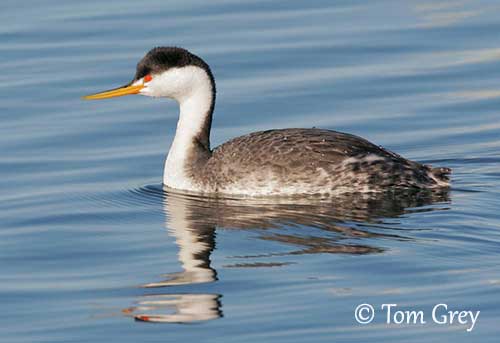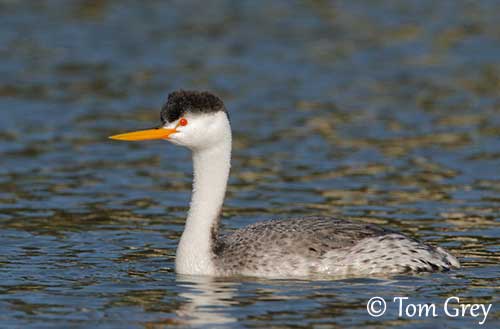
Fr: Grèbe à face blanche
Ang: Clark's Grebe
All: Clarktaucher
Esp: Achichilique de Clark
Ita: Svasso di Clark
Nd: Clarks Fuut
Sd: ljus svandopping
Photographer:
Tom Grey
Tom Grey's Bird Pictures & Tom Grey's Bird Pictures 2
Texte de Nicole Bouglouan
Sources:
HANDBOOK OF THE BIRDS OF THE WORLD vol 1 by Josep del Hoyo-Andrew Elliot-Jordi Sargatal - Lynx Edicions - ISBN: 8487334105
A GUIDE TO THE BIRDS OF MEXICO AND NORTHERN CENTRAL AMERICA by Steve N. G. Howell, Sophie Webb - Oxford University Press - ISBN: 0198540124
FIELD GUIDE TO THE BIRDS OF NORTH AMERICA - National Geographic Society - ISBN: 0792274512
Bird Web (Seattle Audubon Society)
South Dakota Birds and Birding – (Terry L. Sohl)
SORA- IDENTIFICATION AND DISTRIBUTION OF CLARK'S GREBE
Journal of Experimental Biology
What Bird-The ultimate Bird Guide (Mitchell Waite)
Wikipedia, the free encyclopaedia
Clark’s Grebe
Aechmophorus clarkii
Podicipediformes Order – Podicipedidae Family
INTRODUCTION:
The Clark’s Grebe is very similar to the Western Grebe to which it is closely related. Until recently, both were considered to be only one species named Western Grebe (A. occidentalis) but with two colour morphs, occasionally treated as subspecies.
However, the light morph is now considered a different species, the Clark’s Grebe. They are very similar in appearance but they show different feeding behaviour, especially in the choice of their feeding areas. On the other hand, they have different advertising call that helps to prevent hybridization, and reports about interbreeding are rare.
The Clark’s Grebe and the Western Grebe were only split into two distinct species in 1985.
The Clark’s Grebe is a North American species found mainly throughout the Western half of North America, and two subspecies are recognized. They frequent aquatic habitats including freshwater lakes when breeding and freshwater and saltwater coasts during winter.
It feeds primarily on fish, but other prey such as crustaceans, marine worms and insects are also part of the diet. It forages by diving and swimming like other grebes.
During the breeding season, the Clark’s Grebe performs spectacular courtship displays very similar to those of the Western Grebe, involving synchronized racing across the water in vertical position.
The Clark’s Grebe is not considered globally threatened, although drainage of wetlands for agriculture expansion and use of pesticides affect the numbers and reduce the nesting habitat.

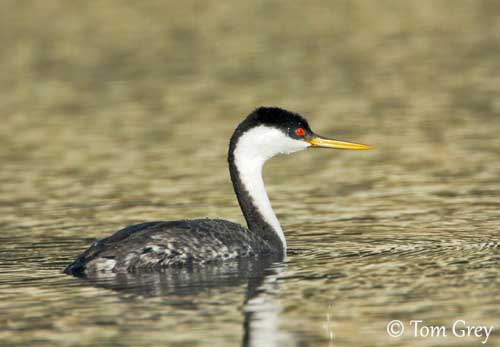
DESCRIPTION OF THE BIRD:
Biometrics:
Length: 51-74 cm
Weight: 718-1258 g
The Clark’s Grebe is a large, slender grebe with long neck and long, thin bill. The plumage is dark grey above and white below.
Compared to the Western Grebe, the Clark’s Grebe has paler back and flanks show less extensive black. On the hindneck, the black stripe is narrower. On the wings, there is less white on the flight-feathers. Crown, neck, wing-coverts and scapulars may have white to pale grey bases.
On the head, the Clark’s Grebe has white of face extending above the eye and onto the lores. In breeding plumage, the black crown feathers are often erected, giving a helmet-like appearance.
The long, thin bill is orange-yellow with well-marked black culmen. The eyes are bright scarlet. Legs and lobbed feet are dull yellow to yellow-green.
Male and female are similar, but the female may appear lighter than male.
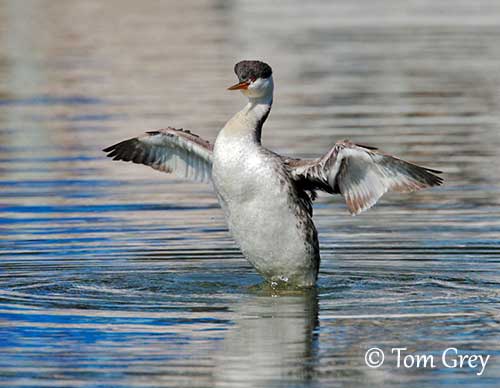
During winter, the loral area acquires more black, including above the eyes. This pattern looks more like the Western Grebe. Crown and hindneck are duller, less clearly separated from white face and foreneck.
The juvenile resembles non-breeding adult with greyer appearance.
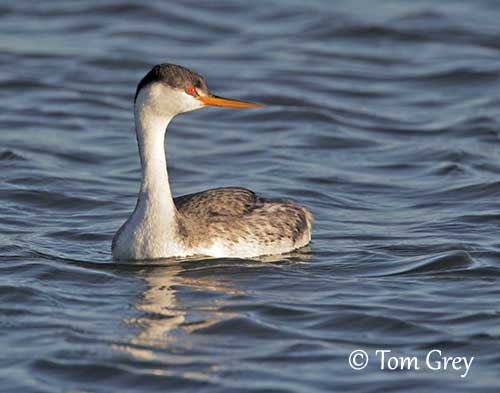
SUBSPECIES AND RANGE:
The Clark’s Grebe has two subspecies that differ in size, and especially wing length.
A.c. transitionalis breeds from SW Canada S through W USA to N Baja California and Mexico. It winters on the coasts of the south of the breeding range, and there are some scattered records farther E.
A.c. clarkii (described above) is resident on the Mexican Plateau from N Chihuahua to N Guerrero and W to Nayarit.
HABITAT:
The Clark’s Grebe breeds in freshwater wetlands such as lakes and marshes, and open waters bordered with emergent vegetation.
During winter, it can be found in salt or brackish bays, estuaries and sheltered sea coasts. It may occasionally frequent rivers, but less frequently freshwater lakes.
CALLS AND SONGS: SOUNDS BY XENO-CANTO
The calls of the Clark’s Grebe are similar to those of the Western Grebe, but during the courtship displays, the present species gives an advertising call to attract mates, a single, extended “kreeeed” different from the two-note call “kreed-kreet” of the Western Grebe. This call is usually given in bouts.
BEHAVIOUR IN THE WILD:
The Clark’s Grebe feeds primarily on fish, but it also takes crustaceans, marine worms, salamanders, grasshoppers, aquatic insects and their larvae.
It hunts by diving deeply and swimming around. When a prey is located, it quickly jabs with the bill to spear the food item, but it may also catch it between the mandibles.
It may dive until the bottom to reach some prey items, but it probably hunts mainly in shallow water. The fish is usually pursued under water.
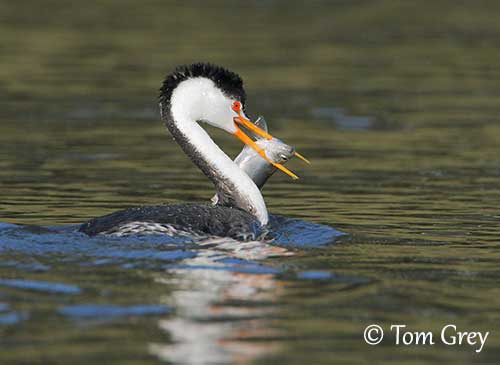
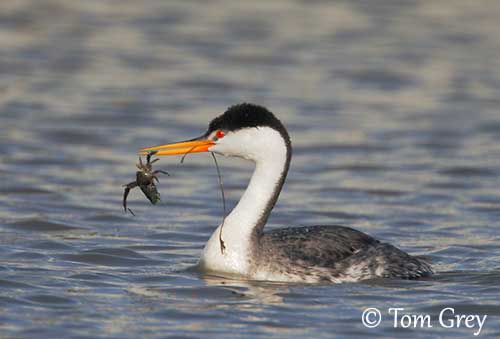
Unlike the Western Grebe, the Clark’s Grebe tends to forage farther to the shore, and also in deeper water. Like most fish-eating grebes, it also eats some of its own feathers to protect the digestive tract from sharp bones.
The Clark’s Grebe and its closely related Western Grebe perform spectacular courtship displays and some of the most complex known for any bird because only a few animals are able to run on the water.
The “Rushing Ceremony” is used to attract a mate and reinforces the pair-bond. This display involves two grebes or more propelling themselves out of the water to run on the water surface. The wings are not used during this behaviour and they are held behind the body. During this display, the grebes usually move 5 to 20 metres over the water.
This display is performed throughout the breeding season, but it becomes irregular after pairing and the start of the nesting period. This behaviour is performed by two males, a male and a female, or several males and one female, accompanied by raucous calls and loud splashes.
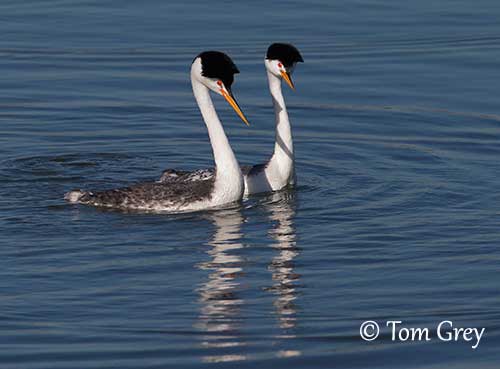
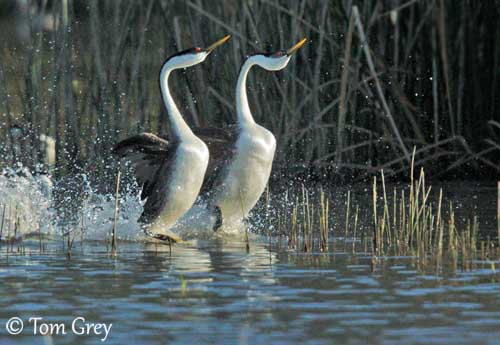
This is the "Rushing Ceremony" involving two grebes running on water surface in vertical position
Other display, the “Weed Ceremony” is performed once the pair is well established. Both mates swim away from each other and submerge slowly. They reappear with weeds in their bills. They move towards each other and suddenly rise up vertically, breast to breast, rocking quickly their heads from side to side while rubbing each other with the weeds.
But other displays are also performed, similar to other grebe species.
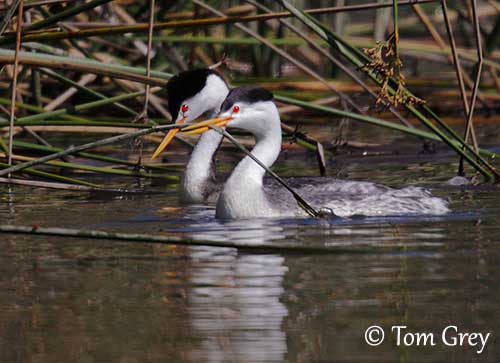
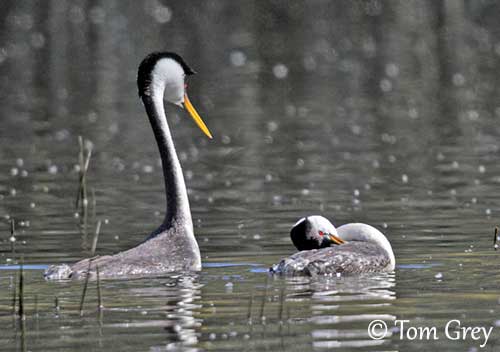
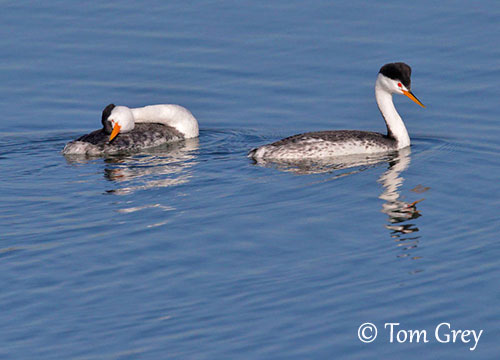
The nest-site is selected by the male, in shallow water and sheltered from wave action. Both mates build the nest, a mound of vegetation with a shallow cup in the centre for the eggs. It is usually anchored to submerged log or root. The male often feeds the female during the first period of the breeding season. They are territorial and they share all the nesting duties. They are monogamous.
The Clark’s Grebe of nominate race is resident in its Mexican range, with probably some local movements.
The race A.c. transitionalis of North America moves to the coasts.
The Clark’s Grebe is rarely seen in flight, but once in the air, the flight is swift and direct with rapid wingbeats.
REPRODUCTION OF THIS SPECIES:
The laying takes place in May-July in the USA, but it is usually more extended in Mexico with eggs between May and October.
The Clark’s Grebe is colonial and may also breed in large mixed colonies with the Western Grebe, with hundreds and even thousands of nests.
The nest-site selected by the male is near the water’s edge and among the emergent vegetation including rushes and reeds. The nest is built in very shallow water, usually less than 30 centimetres depth. It is sheltered from water movements and wave action.
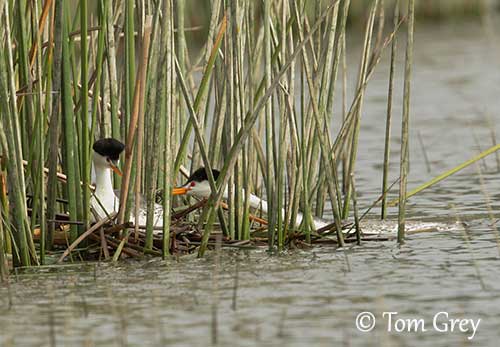
Both adults build the nest, a mound of vegetation with a cup-shaped depression in the centre for the eggs. It is made with aquatic vegetation and anchored to submerged log or root, or to the vegetation. This structure may also rest on the bottom or is floating.
The male brings larger materials because it has a larger bill, while the female brings mainly wet algae.
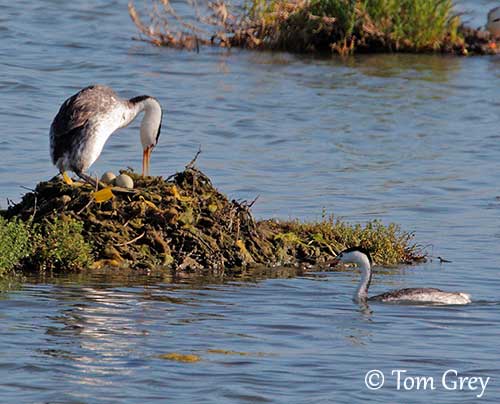
The female usually lays 3-4 pale blue eggs becoming stained in the wet nest. Both adults share the incubation during 23 days. At hatching, the chicks are paler grey than the chicks of the Western Grebe, but both lack the typical striped pattern of most young grebes. They fledge about 63-77 days after hatching.
Like other young grebes, the chicks can be seen riding on the adult’s backs during the first weeks of their life.
This species usually produces a single brood per season.
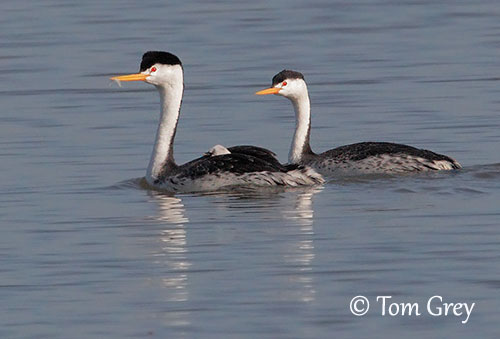
PROTECTION / THREATS / STATUS:
The Clark’s Grebe may be affected by drainage of wetlands for agriculture expansion, and the use of pesticides reduces some populations, especially in California. The nesting areas are often disturbed by human activities involving difficulties to form the colonies.
The main food of this species, the fish, is reduced by increasing salinity in lakes in Nevada and other states of the Great Basin.
The population is roughly estimated to number 7,300/14,000 mature individuals.
However, the Clark’s Grebe is not considered globally threatened, and the species is currently evaluated as Least Concern.
